Different methods of adulteration of crude drugs
What is adulteration.
There are following methods of adulteration of crude drugs.
storage, processing, transport and distribution of foods are also considered.
“Adulterant” means any material which is or could be employed for making the food unsafe or sub-standard or mis-branded or containing extraneous matter.
Food is declared adulterated if:
- A substance is added which depreciates or injuriously affects it.
- Cheaper or inferior substances are substituted wholly or in part.
- Any valuable or necessary constituent has been wholly or in part abstracted.
- It is an imitation.
- It is colored or otherwise treated, to improve its appearance or if it contains any added substance injurious to health.
- For whatever reasons its quality is below the Standard
Adulterated food is dangerous because it may be toxic and can affect health and it could deprive nutrients essential for proper growth and development.
Common adulterated foods
Some of the common adulterated foods are milk and milk products, atta, edible oils, cereals, condiments (whole and ground), pulses, coffee, tea, confectionary, baking powder, non - alcoholic beverages, vinegar, besan and curry powder.
Types of adulterants
| Type | Substances Added |
|---|---|
| Intentional Adulterants | Sand, marble chips, stones, mud, other filth, talc, chalk powder, water, mineral oil and harmful colour. |
| Incidental adulterants | Pesticide residues, droppings of rodents, larvae in foods. |
| Metallic contaminants | Arsenic from pesticides, lead from water, effluent from chemical industries, tin from cans. |
Poisonous or Deleterious Substances
If a food contains a poisonous substance in excess of a tolerance, regulatory limit, or action level, mixing it with "clean" food to reduce the level of contamination is not allowed. The deliberate mixing of adulterated food with good food renders the finished product adulterated
Filth and Foreign Matter
Filth and extraneous material include any objectionable substances in foods, such as foreign matter (for example, glass, metal, plastic, wood, stones, sand, cigarette butts), undesirable parts of the raw plant material (such as stems, pits in pitted olives, pieces of shell in canned oysters), and filth (namely, mold, rot, insect and rodent parts, excreta, decomposition.
Economic Adulteration
A food is adulterated if it omits a valuable constituent or substitutes another substance, in whole or in part, for a valuable constituent (for instance, olive oil diluted with tea tree oil); conceals damage or inferiority in any manner (such as fresh fruit with food coloring on its surface to conceal defects); or any substance has been added to it or packed with it to increase its bulk or weight, reduce its quality or strength, or make it appear bigger or of greater value than it is (for example, scallops to which water has been added to make them heavier).
Microbiological Contamination and Adulteration
The fact that a food is contaminated with pathogens (harmful microorganisms such as bacteria, viruses, or protozoa) may, or may not, render it adulterated. Generally, for ready -to-eat foods, the presence of pathogens will render the food adulterated. For example, the presence of Salmonella on fresh fruits or vegetables or in ready-to-eat meat or poultry products (such as luncheon meats) will render those products adulterated.
Ready -to- eat meat and poultry products contaminated with pathogens, such as Salmonella or Listeria monocytogenes, are adulterated. For raw meat or poultry products, the presence of pathogens will not always render a product adulterated (because raw meat and poultry products are intended to be cooked and proper cooking should kill pathogens).
- 1.INTENTIONAL ADULTERATION
Generally, the drugs are adulterated by substitution with substandard commercial varieties, inferior drugs or artificially manufactured commodities. The different types of adulterants found in market are given here.
1) Adulteration using manufactured substances
In this type of adulteration the original substances are adulterated by material that are artificially manufactured. The materials are prepared in a way that their general form and appearance resemble with various drugs.
Eg. Cargo of ergot from Portugal was adulterated with small masses of flour dough moulded to the correct size and shape and coloured, first using red ink, and then into writing ink.
Artificial invert sugar is used in place of honey. Paraffin wax coloured yellow and is been substituted for beeswax. Compressed chicory is used in place of coffee berries. Bass-wood is cut exactly the required shape of nutmeg and used to adulterate nutmeg.
2)substitution using inferior commercial varieties
In this type, the original drugs are substituted using inferior quality drugs that may be similar in morphological characters, chemical constituents or therapeutic activity.
Eg. Hog gum or hog tragacanth for tragacanth gum, Mangosteen fruits for bael fruits, arabian senna, obovate senna and provence senna are used to adulterate senna, ginger being adulterated with cochin,African and Japanese ginger.
3)substitution using exhausted drugs
In this type of substitution, the active medicaments of the main drugs are extracted out and are used again. this could be done for the commodities that would retain its shape and appearance even after extraction, or the appearance and taste could be made to the required state by adding colouring or flavouringagents.
This technique is frequently adopted for the drugs containing volatile oil, such as clove, Fennel, etc. Eg. After extraction, Saffron and red rose petals are recoloured by artificial dyes.
The bitterness of exhausted gentian is restored by adding aloes.
4)substitution of superficially similar inferior natural substance
The substituents used may be morphologically similar but will not be having any relation to the genuine article in their constituents or therapeutic activity.
Eg. Ailanthusleaves are substituted for belladonna, senna leaves, Saffron admixed with saff flower Peach kernels and apricot kernel for almonds 5)Adulteration using the vegetative part of the same plantThe presence of vegetative parts of the same plant with the drug in excessive amount is also an adulteration.
Eg. Epiphytes, such as mosses, liverworts and lichens that grow over the barks also may occur in unusual amounts with the drugs, Excessive amount of stems in drugs like lobelia, stramonium, hamamelis leaves,etc.
6) Addition of toxic materials
In this type of adulteration, the materials used for adulteration would be toxic in nature. A big mass of stone was found in the centre of a bale of liquorice root. lime stone pieces with asafoetida, lead shot in opium, amber coloured glass pieces in colophony
. 7) Adulteration of powdersPowdered drugs are found to be adulterated very frequently.
Adulterants used are generally powdered waste products of a suitable colour and density. Powdered olive stones for powdered gentian, liquorice or pepper, brick powder for barks. 8) Addition of synthetic principlesSynthetic pharmaceutical principles are used for market and therapeutic value.
Eg. Citral is added to lemon oil, diabetes angel containing glyburide and phenformin , sleeping buddha containing estazolam.
2.UNINTENTIONAL ADULTERATION
Unintentional adulteration may be due to the following reasons:
1)confusion in vernacular names between indigenous systems of medicine and local dialects
2) lack of knowledge about the authentic plant
3) non availability of the authentic plant
4) similarity in morphology and or aroma
5) careless collection
6) other unknown reasons Name confusionIn Ayurveda ,’Parpatta’ refer to Fumaria parviflora. In siddha, ‘Parpadagam’refer to Mollugo Pentaphylla.
Owing to the similarity in the names in traditional system of medicine , these two herbs are often interchanged or adulterated or substituted. Because of the popularity of siddha medicine in some parts of south India, traders in these regions supply M.Pentaphylla as Parpatta/Parpadagam and the north Indian suppliers supply F.Parviflora.
These two can be easily identified by the presence of pale yellow to mild brown coloured, thin wiry stems and small simple leaves of M.Pentaphylla and black to dark brown -coloured, digitate leaves with narrow segments of F.Parviflora. Lack of knowledge about authentic sourceNagakesar is one of the important drugs in Ayurveda. The authentic source is Mesua ferrea.
However, market sample are adulterated with flowers of calophyllum inophyllum. Though the authentic plant is available in plenty throughout the western ghats and parts of the Himalayas, suppliers are unaware of it. There may also be some restrictions in forest collection. Due to these reasons, C. inophyllum is sold as Nagkesar.
Authentic flowers can be easily identified by the presence of two- celled ovary, whereas in case of spurious flowers they are single celled. Similarity in morphologyMucuna pruriens is the best example for unknown authentic plant and similarity in morphology. It is adulterated with similar papilionaceae seeds. M.utilis(sold as white variety) and M.deeringiana (sold as bigger variety) are popular adulterants.
Apart from this, M.cochinchinensis, Canavalia variso and C.ensiformis are also sold in Indian markets. Authentic seeds are upto 1cm in length with shining mosaic pattern of black and brown colour on their surface. M.deeringiana and M.utilis are bigger (1.5-2cm) in size. M.deeringgiana is dull black, whereas M.utilis is white or buff coloured. Lack of authentic plantHypericum perforatumis cultivated and sold in European markets.
In India, availability of this species in very limited. However, the abundant Indo-Nepal species H.patulumis sold in the name of H.perforatum. Market sample is a whole plant with flowers, and it is easy to identify them taxonomically. Anatomically, stem transverse section of H.perforatum has compressed thin phloem, hollow pith and absence of calcium oxalate crystals.
On the other hand,H.patulum has broader phloem, partially hollow pith and presense of calcium oxalate crystals. Similarity in colourIt is well known that in course of time, drug materials get changed to or substituted with other plant species.
Eg. Ratanjot – On discussion with supplier and non-timer forest product (NTFP) contractors, it came to be known that in the past, roots of ventilago madraspatana were collected from western Ghats, as the only source of Ratanjot.
However, that is not the practice now. It is clearly known that Arnebia euchroma var euchroma is the present source. Similarity in yielding a red dye, A. euchroma substitutes V. madraspatana. The description to identify these two is unnecessary because of the absence of V. madraspatanain market. Whatever is available in the market, in the name of Ratanjot, was originated from A.euchroma.
Careless collectionssome of the herbal adulterations are due to the carelessness of herbal collectors and suppliers. Parmelia perlata is used in ayurveda, unani, and siddha. It is also used as grocery. Market samples showed it to be admixed with other species (P.perforata and P.cirrhata).
Sometimes, Usnea sp. is also mixed with them. Authentic plants can be identified by their thallus nature. Unknown reasonsVidari is another example of unknown authentic plant. It is an important ayurvedic plant used extensively.
Its authentic source is Pueraria tuberosa, and its substitute is Ipomoea digitata. However, market samples are not derived from these two. It is interesting to know that an endangered gymnosperm cycas circinalis is sold in plenty as vidari.
The adulterated materials originated from Kerala, India. Although both the authentic plant and its substitute are available in plenty throughout India, how C.circinalis became a major source for this drug is unknown. P.tuberosa can be easily identified by the presence of papery flake-like tubers, I.digitata by the presence of its concentric rings of vascular bundles and their adulterant C.circinalis by its leaf scars and absence of vessel elements.
 Huzaifa Ansar
5:15 PM
Huzaifa Ansar
5:15 PM
Assembler Directives of 8085
Assembler directives are the instructions used by the assembler at the time of assembling a source program. More specifically, we can say, assembler directives are the commands or instructions that control the operation of the assembler.
Assembler directives are the instructions provided to the assembler, not the processor as the processor has nothing to do with these instructions. These instructions are also known as pseudo-instructions or pseudo-opcode.
Assembler Directives of 8085
The assembler directives given below are used by 8085 and 8086 assemblers:
DB: Define Byte
This directive is used for the purpose of allocating and initializing single or multiple data bytes.

Memory name AREA has three consecutive locations where 30H, 52H and 35H are to be stored.
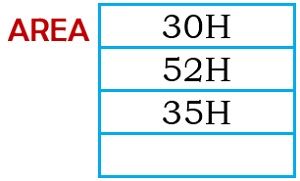
DW: Define Word
It is used for initialising single or multiple data words (16-bit).![]()
These two 16-bit data 1020H and 4216H are stored at 4 consecutive locations in the memory MARK.
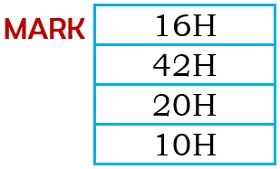
END: End of program
This directive is used at the time of program termination.
EQU: Equate
It is used to assign any numerical value or constant to the variable.
![]()
Variable name ‘DONE’ has value 10H
MACRO: Represents beginning
Shows the beginning of macro along with defining name and parameters.
ENDM: End of macro
ENDM indicates the termination of macro.
where macroname (STEP) is specified by the user.
ORG: Origin
This directive is used at the time of assigning starting address for a module or segment.

By this instruction, the assembler gets to know that the statements following this instruction, must be stored in the memory location beginning with address 1050H.
Assembler Directives of 8086
These assembler directives are specifically used by 8086:
ASSUME: Shows the segment name to the assembler
It provides information to the assembler regarding the name of the program or data segment for that particular segment.
![]()
This directive specifies that the instruction of the source program is stored in logical segment _DONE.
DD: Define Double word
This directive allows the initialization of single or multiple data in the form of double words (i.e., 4 bytes). The is used to inform the assembler that the stored data in memory is a double word.
![]()
Thus memory stores the given data in the form:
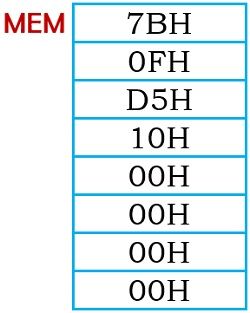
DQ: Define Quad words
It is used to initialise quad words (8-bytes) either one or more than one. Thereby informing the assembler that the data stored in memory is quad-word.
DT: Define ten bytes
It is used to allocate and initialize 10 bytes of a variable.
DUP: Duplicate
DUP allows initialization of multiple locations and assigning of values to them. This allows storing of repeated characters or variables in different locations.
![]()
So this permits the storing of these data in memory and creating 8 identical sets in the memory identified as Book.
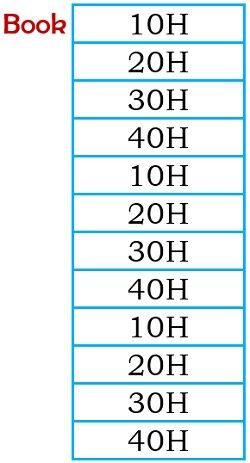
DWORD: Double word
This directive is used to indicate that the operand is of double word size.
PROC: Procedure
It defines the starting of a procedure/subroutine.
FAR: This directive is a type specifier that is used by the assembler to declare intersegment call (i.e., call from different segment).
NEAR: This is used for intrasegment call i.e., a call within the same segment.
ENDP: End of procedure
This directive shows the termination of a procedure.
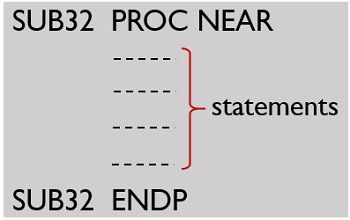
SEGMENT: Beginning of a memory segment.
It is used to show the beginning of a memory segment with a specific name.
ENDS: End of segment
This directive defines the termination of a particular memory segment as it is specified by its name.
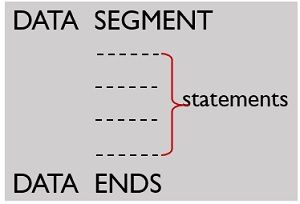
The statements within the segment are nothing but the program code.
EVEN: It is used to inform the assembler to align the data beginning from an even address.
As data specified with an odd starting address requires 2 byte accessing. Thus using this directive, data can be aligned with an even starting address.
PTR: Pointer
This directive shows information regarding the size of the operand.
![]()
This shows legal near jump to BX.
PUBLIC: This directive is used to provide a declaration to variables that are common for different program modules.
STACK: This directive shows the presence of a stack segment.

SHORT: This is used in reference to jump instruction in order to assign a displacement of one byte.
THIS: It is used along with EQU directive for setting the label to either, byte, word or double-word.
So, these assembler directives are used by the processors for controlling the generation of machine code and organization of the program.
Mathematics - 4 AKTU Quantum - Quantum Series
UNIT-1: PARTIAL DIFFERENTIAL EQUATIONS (1-1 C to 1-23 C)
Origin of Partial Differential Equations, Linear and Non Linear Partial Equations of first order, Lagrange's Equations, Charpit's method, Cauchy's method of Characteristics, Solution of Linear Partial Differential Equation of Higher order with constant coefficients, Equations reducible to linear partial differential equations with constant coefficients.
UNIT-2 : APPLICATIONS OF PARTIAL DIFFERENTIAL EQUATIONS (2-1 C to 2-39 C)
Classification of linear partial differential equation of second order, Method of separation of variables, Solution of wave and heat conduction equation up to two dimension, Laplace equation in two dimensions, Equations of Transmission lines.
UNIT 3 : STATISTICAL TECHNIQUES—I (3-1 C to 3-23 C)
Introduction: Measures of central tendency, Moments, Moment generating function (Ma), Skewness, Kurtosis, Curve Fitting, Method of least squares, Fitting of straight lines, Fitting of second degree parabola, Exponential curves, Correlation and Rank correlation, Regression Analysis: Regression lines of y on x and x on y, regression coefficients, properties of regressions coefficients and non linear regression.
UNIT-4 : STATISTICAL TECHNIQUES—II (4-1 C to 4-23 C)
Probability and Distribution: Introduction, Addition and multiplication law of probability, Conditional probability, Baye's theorem, Random variables (Discrete and Continuous Random variable) Probability mass function and Probability density function, Expectation and variance, Discrete and Continuous Probability distribution: Binomial, Poission and Normal distributions.
null
UNIT-5 : STATISTICAL TECHNIQUES-Ill ' (5-1 C to 5-33 C)
Sampling, Testing of Hypothesis and Statistical Quality Control: Introduction, Sampling Theory (Small and Large), Hypothesis, Null hypothesis, Alternative hypothesis, Testing a Hypothesis, Level of significance, Confidence limits, Test of significance of difference of means, T-test, F-test and Chi-square test, One way Analysis of Variance (ANOVA). Statistical Quality Control (SQC), Control Charts, Control Charts for variables ( X and R Charts), Control Charts for Variables (p, np and C charts).
 Huzaifa Ansar
7:30 PM
Huzaifa Ansar
7:30 PM
 Huzaifa Ansar
5:57 AM
Huzaifa Ansar
5:57 AM












